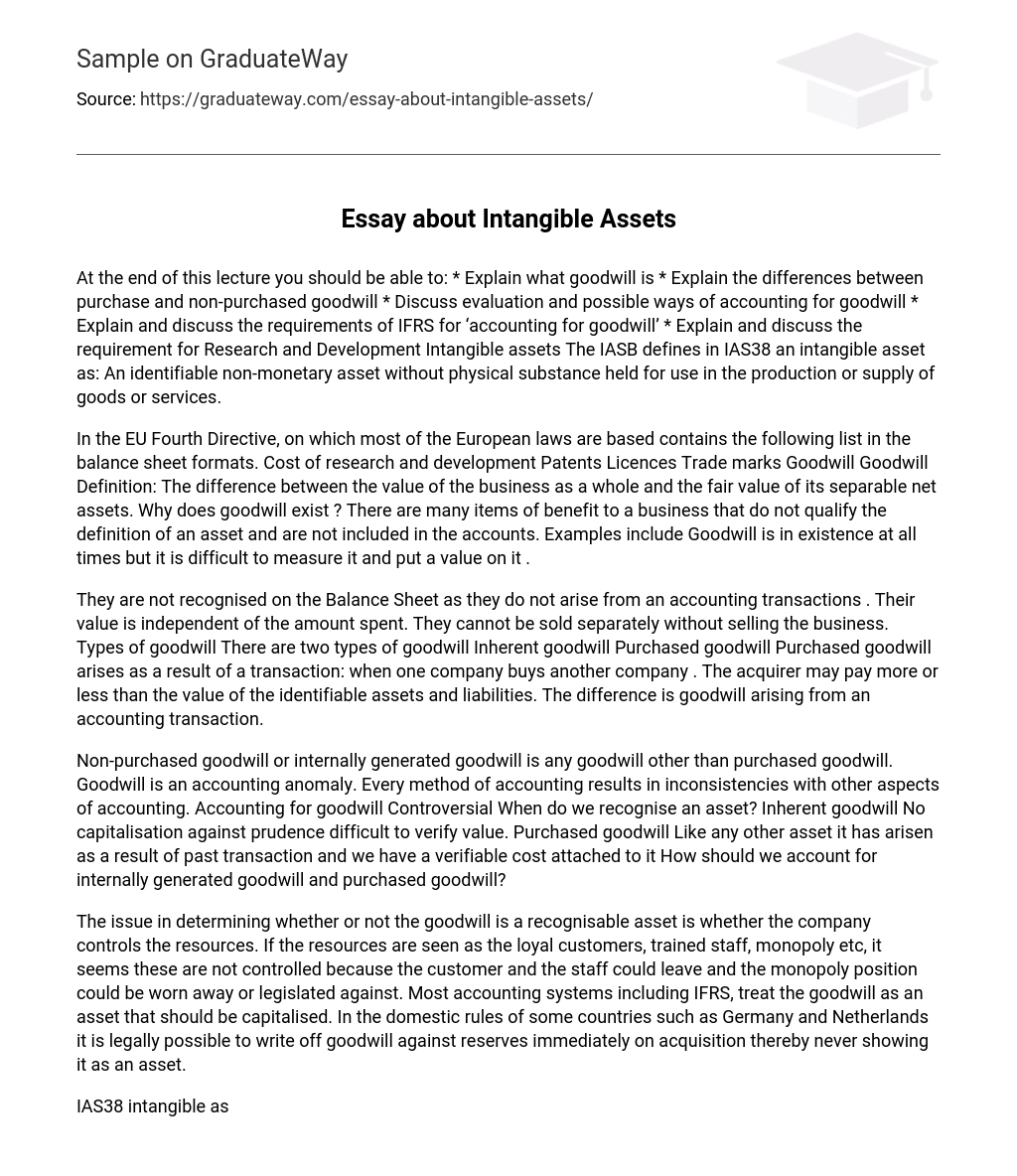By the end of this lecture, you will be able to:
- Explain what goodwill is
- Discuss the differences between purchase and non-purchased goodwill
- Evaluate and account for goodwill using various methods
- Explain the requirements of IFRS for accounting for goodwill
- Understand Research and Development Intangible assets as defined by IAS38: identifiable non-monetary assets without physical substance held for use in producing or supplying goods or services.
The EU Fourth Directive, on which most European laws are based, includes the following list in balance sheet formats:
- Cost of research and development
- Patents
- Licences
- Trade marks
- Goodwill
Goodwill Definition: The difference between the value of the business as a whole and the fair value of its separable net assets.
Why does goodwill exist? There are many items that benefit a business but do not qualify as assets or get included in accounts. Examples include customer loyalty, brand recognition, and reputation. Goodwill exists at all times but is difficult to measure and put a value on.
Goodwill is not recognized on the balance sheet as it does not arise from an accounting transaction. Its value is independent of the amount spent and cannot be sold separately without selling the business. There are two types of goodwill: inherent goodwill and purchased goodwill. Purchased goodwill arises as a result of a transaction when one company buys another company. The acquirer may pay more or less than the value of identifiable assets and liabilities, and the difference is goodwill arising from an accounting transaction.
Non-purchased goodwill, also known as internally generated goodwill, refers to any goodwill that is not acquired through a purchase. Goodwill itself is an accounting anomaly, as every accounting method leads to inconsistencies with other aspects of accounting. The controversy surrounding the accounting for goodwill arises from the question of when we should recognize it as an asset. Inherent goodwill presents difficulties in terms of capitalization against prudence and verifying its value. On the other hand, purchased goodwill is treated like any other asset and has a verifiable cost attached to it. The question then becomes how we should account for both internally generated and purchased goodwill.
The issue in determining whether or not goodwill is a recognizable asset is whether the company controls the resources. If these resources are seen as loyal customers, trained staff, monopoly, etc., it seems that they are not controlled because customers and staff could leave and the monopoly position could be worn away or legislated against. However, most accounting systems including IFRS treat goodwill as an asset that should be capitalized. In some countries such as Germany and Netherlands, it is legally possible to write off goodwill against reserves immediately on acquisition thereby never showing it as an asset.
IAS38 Intangible Assets requires that the asset must arise from contractual or legal rights or be separable. However, this requirement seems to conflict with the definition of an asset, which includes a requirement for control.
Regarding goodwill, like other assets, it wears out over time. However, assessing its useful economic life is problematic because it is not clear what goodwill actually represents.
However, some argue that not only will goodwill not lose its value, but it will also increase over time. Under international accounting standards, annual goodwill amortization charges are replaced by an impairment test to be carried out at least once a year. This impairment test also applies to any other intangible assets with an indefinite useful life. Intangibles with finite lives continue to be amortized (subject to impairment). However, unlike UK GAAP and previous IFRS standards, there is no rebuttable presumption of a maximum useful life of 20 years. An impairment review is conducted.
Charge goodwill to the profit and loss account only if its carrying value is not supported by the acquired business’s value of goodwill. Test for impairment. Systematic amortisation is a practical way to recognise the reduction in goodwill’s value with limited useful economic life. Goodwill and intangible assets with limited useful economic lives should be amortised systematically over those lives. Goodwill and intangible assets with indefinite useful economic lives should not be amortised.





